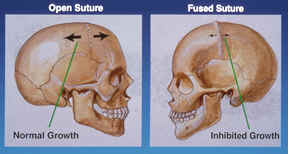

 |

|
|
 |
There are four different kinds of single suture synostosis; each type is caused by a different suture of the skull fusing shut. These single sutural synostoses all share some features in common which are discussed below. Following this discussion, the various types of synostosis (sagittal, coronal, metopic and lambdoid) are discussed individually. Finally, the surgical treatment is discussed. To start with, it is important to determine if a child truly has craniosynostosis, as the most common cause for an abnormal skull shape is not craniosynostosis, but is positional plagiocephaly. Positional plagiocephaly (aka. skull deformation) is discussed elsewhere on this site (see Deformations). |
|
Listed below are the four types of single sutural
synostosis: Sometimes, more than one of these types of craniosynostoses can occur together. If both coronal sutures are involved, or closed, then your child probably has one of the craniofacial dysostoses. For a good starting point, please refer to the sections on Apert, Crouzon, and Pfeiffer syndromes. Physical Traits: Rationale for Treatment: It is important to discuss the specifics of any proposed operation with your craniofacial surgeon to make sure that you understand what is being done and why. |